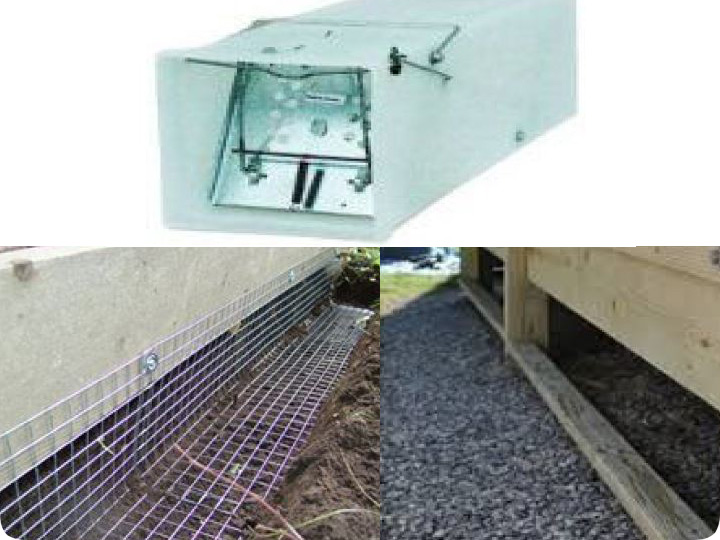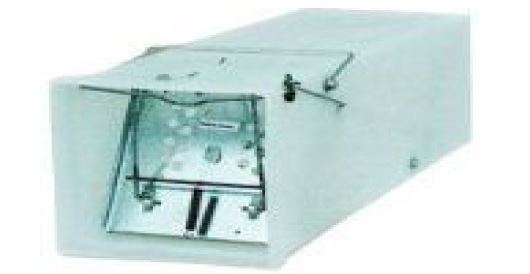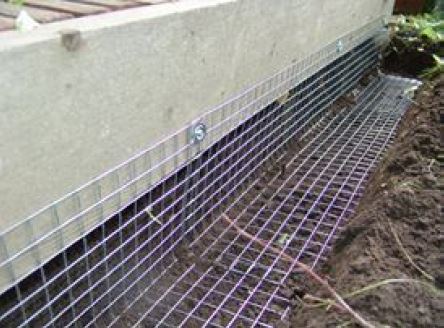-
info@aaanimalcontrol.com
Call us for help in your town
Humane Wildlife Education
Skunk Problems Around Buildings

Skunks will burrow under things - decks, sheds, etc.,where they sleep through a bitter cold spell, or make a nest in the spring to raise a litter. When a garage door is left open, a wandering skunk will enter and find a place to hide, such as a under lawn mower deck, or in a pile of junk. Skunks follow structure when travelling and when waddling along the side of a house may fall into an open window well. If this happens, placing a board in the well allows the skunk to climb out.
Male skunks will fight over females in breeding season (Feb. - March) and spray each other during the contest. They pick a fight arena that provides overhead security - a low deck does just fine. The odor from this activity will fade over time. If it does not fade, there may be a dead skunk rotting away. In this case the carcass needs to be removed.
When a solitary skunk is the problem, trapping is the usual solution. Bait a cage style trap on the skunks travel path and cover it with a blanket or something that keeps the skunk covered when you remove it, since most skunks will not shoot a target they cannot see. I say “shoot” because the anal glands can direct the juice as a rifle shot stream or a shotgun like blast. There is a skunk specific cage trap (MPC-924) that is fully enclosed, sold by Minnesota Trapline Products. This trap allows for the trapper to approach the trap and pick it up without getting sprayed.

Skunks are omnivores, so a bait that provides a sight and smell attraction will work the best. Where there are free roaming cats a sweet bait/lure combination such as marshmallow with vanilla scent is recommended. Place a small sample of the bait outside the trap and trail a liquid scent lure up to the trap. Put the bulk of the bait behind the trap’s trigger.
Between May and August the number of skunks in a location may include a litter. The female will leave the nest to forage, leaving the litter behind until they are old enough to go with her. Do not trap unless you are sure the young are venturing out or they may die in the den, and create odor. When you are certain the litter is leaving the nest, set multiple baited cage traps around the entrance.
Alternately set an unbaited cage trap to block the entrance. The mother will be leading her young out of the den, and will get caught first. Have several more cages set against the main cage to catch the little ones. Sometimes the mother will be in the cage with the others milling around her loose. These can be scooped up with a net but will probably spray. An immature skunk spray does not have as much gusto, volume or range as an adult.
Immature skunks spray at random but healthy adults will generally spray only when convinced there is a threat. The first warning is stamping of the front paws. If the threat does not back down, the skunk will turn to point it’s rear toward the target. Spray is let go when the threat continues to advance. Savvy trappers learn how to read this body language and use it to get quite close without the skunk spraying.
Skunks are legally classified as fur bearing mammals and are subject to state law. Some states prohibit relocation and release of problem skunks due to rabies concerns. The method used to kill a problem skunk should be cleared with the state governing body, usually the department of fish and game.
When you are sure all of the skunks are gone, any openings leading under the house, deck or crawl space should be sealed to prevent future problems.

The procedure is as follows: dig a shallow trench around the structure. Bend a piece of galvanised weld wire (mesh dimension is one inch by one inch) to span from the opening to the outside edge of the trench. Bend the wire to cover the opening and lay it down in the trench, about one foot out from the bend. Fix the wire to the structure with appropriate fasteners, and use gutter spikes to nail down the wire at the outer end of the trench every two feet.

Backfill the trench with three-quarter crushed stone. This barrier will discourage skunks and most other digging animals.
NOTES
1. A captured skunk will dig through the mesh of a wire cage trap, bringing dirt and sod into the trap, and ruining the lawn below. The trap then weighs more with all this dirt inside. Prevent lawn damage, and a heavy trap, by placing the trap on a piece of plywood.
2. Skunks make many divots in the lawn, looking for Japanese beetle grubs. Get rid of the grubs and the skunks will stop digging by applying milky spore and nematodes at the right time. Ask your state agriculture department for how to do this effectively.
We specialize in nuisance wildlife control - this is the field of removing unwanted wildlife from homes and property, and solving conflicts between people and wild animals. From home inspections to preventative repairs, wildlife trapping, attic cleanups and more, we solve critter problems with professional expertise. Call me, David, or click on the below link to find any one of hundreds of wildlife trappers in every city and town in the US.
Do it yourself: Visit my How To Get Rid of Skunks page for tips and advice.
Get professional help: Visit my Nationwide Pro Directory of wildlife removal experts.
For more wildlife stories, click my Wildlife Blog or click my below banner to hire a local trapper.





















